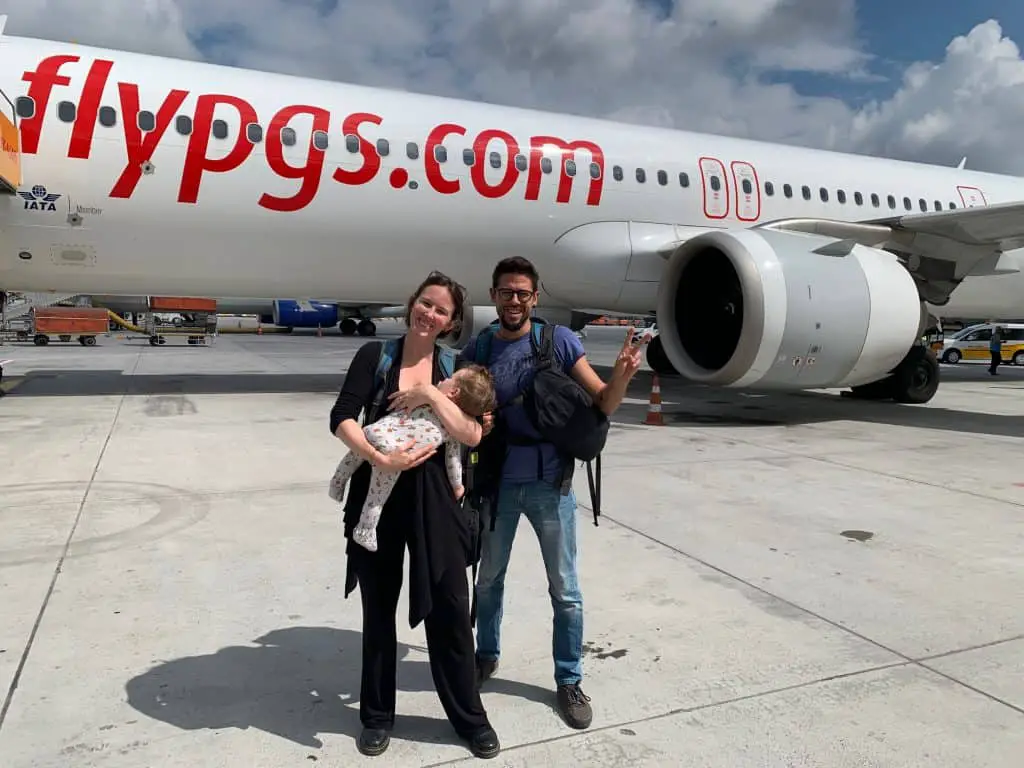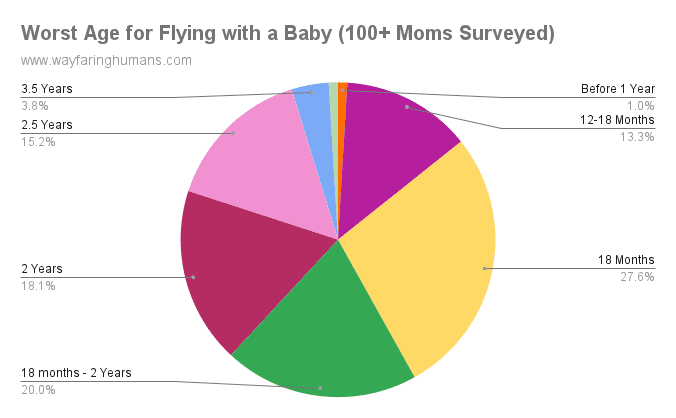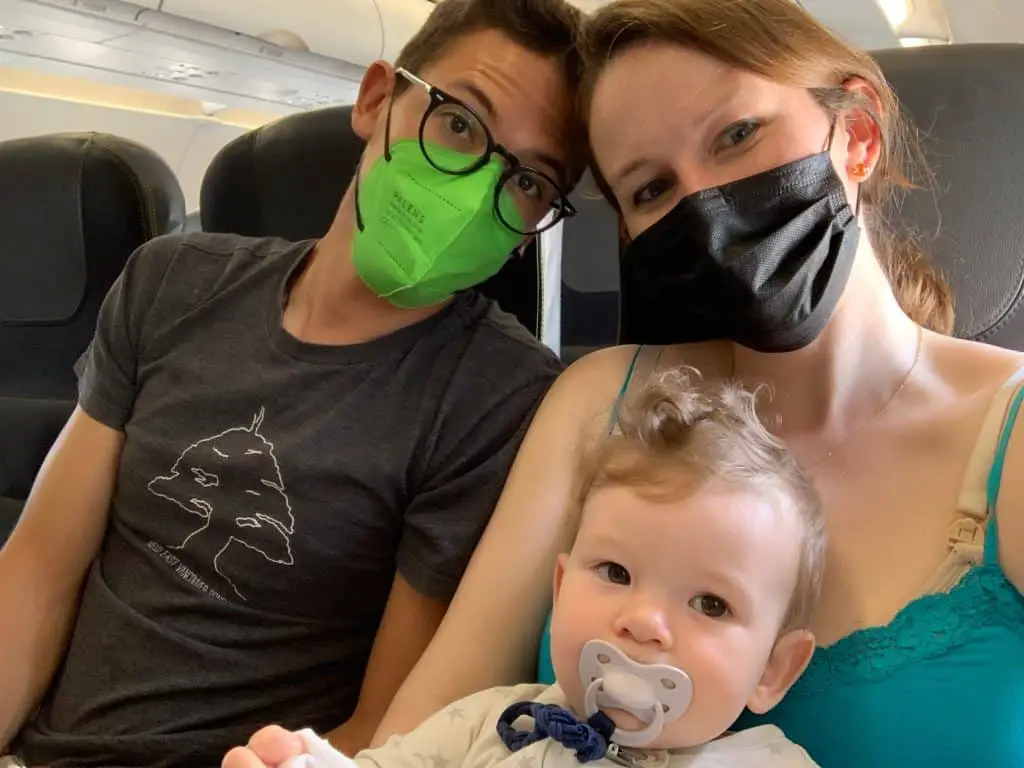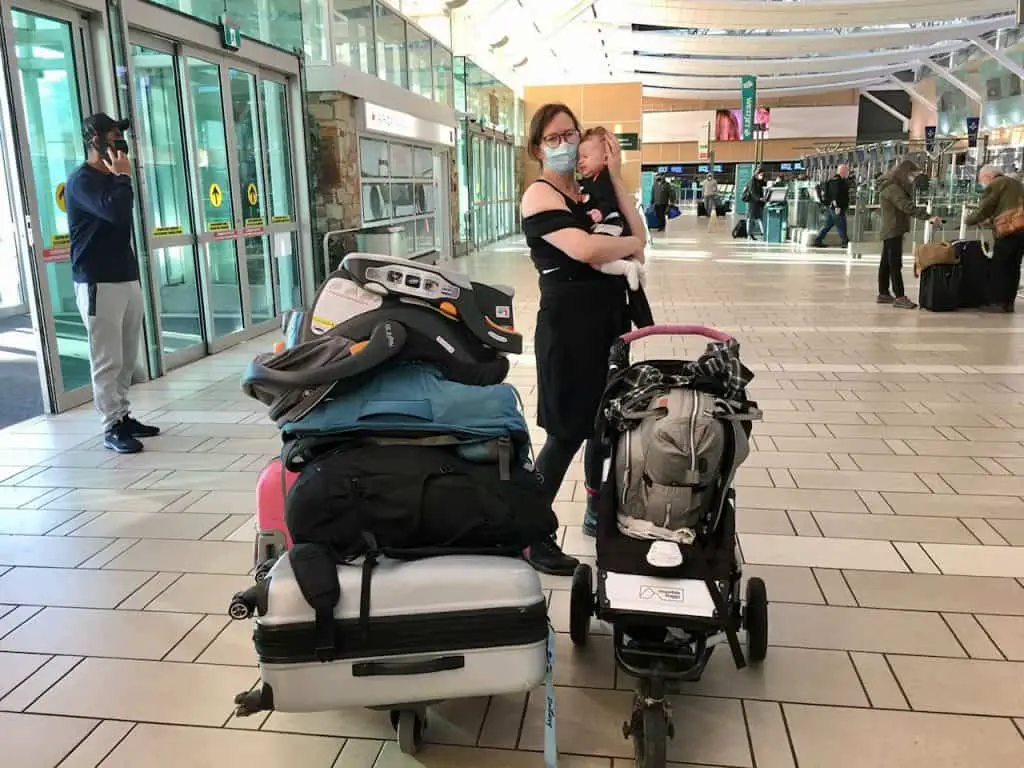I spent almost the entire first year of my son’s life flying with him (domestically and internationally) and it’s been smooth sailing so far. But with the toddler years on the horizon and several upcoming long haul flights booked, I wondered if it was going to get harder for us. To get a better idea, I polled 100+ other traveling moms and asked them: “What is the worst age to fly with a baby?” These were the results of my survey:
Between 12 and 24 months (especially around the 18-month mark) is the worst age to fly with a baby, in terms of difficulty for the parents. This is according to 100+ surveyed mothers who travel with their children. Walking and being unable to follow instructions were sited as the biggest issues.
You’ll learn in this article, however, that the toddler years can also be a wonderful time to travel as a family, as long as certain expectations are dropped and you come prepared with lots of activities and snacks!
Below you’ll find a helpful chart with a breakdown of which ages are the best and worst for little ones to fly (and why!) along with advice and tips for every stage. By the time you’re done reading this article, you’ll feel confident about flying with your baby (or toddler… or child!) and be ready to have a positive experience — no matter their age!

Best & Worst Ages to Travel with a Baby, Toddler, & Child
You’ll notice in the table below that some generalizations are made, but I want to preface this by saying that, of course, all babies and children develop differently and at different times.
It’s not possible to put all children into one neat box for every growth stage, and although this table will give you a pretty good idea of what to expect generally speaking, please take into consideration your own child’s uniqueness and needs 🙂
| AGE | PROS | CONS | TIPS & ADVICE |
| 0-3 Months | They are portable, sleep a lot, and have somewhat predictable schedules. For breastfeeding parents, this stage requires way less “stuff” to pack in terms of feeding (no snacks, baby food, formula, bottles, etc.) or complicated toys, entertainment. | You may still be recovering as the birthing parent and/or very sleep-deprived. Before 2 months, babies don’t yet have their first round of immunizations and are more vulnerable, which can be stressful. | Bring a baby wrap for the airport. To relieve pressure in their ears, try to breastfeed during take off and landing if possible, or offer a bottle or pacifier. Pack extra outfits for everyone and a crinkly toy or two. |
| 4-6 Months | They are still very much portable. They’re not yet mobile, but aren’t as fragile as they are in the newborn stage. Many parents consider this the “sweet spot” for traveling. | Potential unpredictable sleep schedules and sleep regressions. | Pack a few toys and comfort items — many babies at this age are rocked to sleep by the white noise of the plane and are fascinated enough by the safety card and seat belt as “toys.” |
| 7-12 Months | This is when many parents agree that babies start to become the most fun to travel with, because they’re more aware of their surroundings and much more interactive. | Many babies start to become more mobile and begin crawling. This means that they are no longer as happy to sit still in your lap and you may need to do more walks with them down the aisles, let them crawl on the floor, etc. (hello sanitation wipes). | This is when you should take your first “travel toy” trip to the dollar store and pick up some random items to pull out one at a time during the flight for entertainment. Anything new to surprise them with should do! Novelty snacks are also a good idea. |
| 13-18 Months | They are even more interested in the world around them and becoming more interesting themselves! You can have fun showing them things at the airport and on the plane (even better if there are kid areas/playgrounds at the airport). | They can still fly free or cheaply (until age 2) but around now is when you start to wonder whether you should buy them a ticket anyway… Increased mobility (walking!), preferences, and inability to logic or reason starts to make flying a bit more tough! | Pack tons of novelty activities and snacks (the dollar store is your best friend). If screen time is an option, your toddler might sit still long enough for some downloaded videos. Consider getting them their first set of toddler headphones around this stage. |
| 19 Months – 2.5 Years | Some children start to turn a corner somewhere in this stage and “cooperate” a bit more than before/can understand a bit more of what is going on — which can be great for receiving (and following!) your instructions. They also get progressively more fun. | We’ve all heard of the “terrible twos” and that can be exacerbated by travel (toddlers get exhausted, overwhelmed, and act out). They have more complex wants and needs and they are FAST (and can quickly dart away from you in the endless lines). | Prepare your toddler by talking about the airplane days in advance. Bring toys, books, snacks, comfort items, and loaded-up screens (if that’s an option). |
| 2.5 – 3 Years | You’re reaching the end of the toddler years! Children are much easier to explain things to at this age and have longer attention spans (meaning dragging along fewer activities in your carry-on bag). | They are definitely too old for a free/cheap lap infant seat anymore and you’ll have to pay full price for their ticket. Some of the moms in this study chose this age range as the most difficult because of the intensity of older toddler tantrums (more rare, but more intense). | Because your toddler will have to sit in their own seat for take off and landing (with a seat belt on) and cannot sit in your lap, prepare them for this in the days leading up to your flight. Have them practice with you so it’s not a tantrum-inducing surprise on your flight! |
| 4 Years+ | Ah, life is good. Most parents agree that before 1 and after 4 years old, children are great to travel with. At 4, they’re excited to fly, and can easily understand and embrace new experiences. | You’ll be nostalgic for traveling with them as babies, and might even get a bit teary-eyed! Also, they sometimes kick the seat and annoy the person in front of them. | Let them help you pack. Give them some parameters for choosing what they’d like to bring (one toy, one game, one snack, etc.). Talk to them about all the exciting things you’ll do at the airport, on the plane, at your destination… |
| Teenage Years | In theory, they would be fully excited and appreciative that you’re taking them on a plane! | Sigh, this is when some parents said it gets hard again because “teenagers hate everything.” So there’s that to look forward to! | Much like a 4+ year old, talk to them about your upcoming trip. Involve them with the planning as much as possible. |
Why 18 Months is the Hardest Age to Travel with a Child
At the time of writing this article, my own son is 13 months old. We’ve flown with him many times in his first year, and we have some more VERY long flights lined up in the next 6 months or so. Reading the responses from the other moms re: the toddler years, I’m definitely going to prepare myself and keep my expectations low. You’ll see the results in the pie chart below, which shows us:
18 months is the hardest age to travel with a child, according to most of the 100+ mothers surveyed in this study.
I also asked them what the BEST age is to travel with babies — You can find those results here.

I honestly wasn’t surprised as I’ve heard similar stories from other moms I know. 18-month-old babies/toddlers are just coming into their sense of fierce independence. They want what they want, but they can’t express themselves clearly. They’re excited and passionate about everything, and can easily be set off — in either direction! And boy, are they MOBILE.
All of this can be super stressful for traveling parents. As one mother put it:
18 months was the worst for my daughter with basically everything. She’s 3 now and I know more is to come, but that was my least favorite age so far. They want independence, but they don’t have logic yet so they can’t be reasoned with and they have no concept of what will happen if they do something. SO many tantrums.
A mother and flight attendant chimed in:
18 months hands down. As a flight attendant I see kids of all ages. The almost 2-year-old range is tough for most parents I’ve had on flights.
On my next set of flights across North America and the Atlantic with my budding toddler son, I will be bringing plenty of new and exciting activities (from the dollar store, Amazon, and DIY) and TONS OF SNACKS. I’ll also be downloading some videos on my phone (he loves Elmo at the moment) and getting him some affordable toddler headphones.
My diaper bag/carry-on will be stocked and hopefully that will get us through! How are you getting through your toddler year flights? Let me know over on IG.

Important considerations when traveling with babies and young children (aged 0-2 years)
Here are a few more important considerations to make as you plan your travels with babies and toddlers to make sure your trip is not “the worst.” Some of these items don’t necessarily fit neatly into the pros and cons list by age (up above), but they are worth mentioning here:
Germs and sanitation
Airports and airplanes are great places to catch a cold (or something worse!). This is something serious to consider, especially for very young babies who haven’t yet built up their immune systems or had their immunizations. Talk to your doctor before booking any travel plans before 3 months of age.
If you do fly with a baby or toddler, try to wipe down the area around your seats (tray tables, window, arm rests) before you put your baby down. I know from experience that this isn’t always doable or easy with a squirmy baby that grabs everything, but we try to have wipes ready at the top of the diaper bag to do this.
Potty training
This isn’t a bridge I’ve personally crossed just yet, but I can tell you from the stories of my nieces and nephews (and many of the mothers in this survey) that it is NOT easy to travel with a toddler in the midst of potty training!
The advice I was given is this: For travel days, keep the pressure off and expectations low. Put the kids in pull-ups and overnight pull-ups on the plane because there WILL be accidents. Bring extras!
Travel documents
Check your home and destination country’s requirements, because they differ from place to place. However, you’ll find that most international travel, even for infants, will require a passport. For domestic travel, often a birth certificate will suffice.
Car seats on planes
Some parents swear by bringing car seats on the plane and others, like my husband and I, have only done the lap infant routine. Some parents say that they have a MUCH better and more pleasant flying experience by bringing their car seats aboard. Every baby is different so think about whether this option might make your trip go more smoothly!
BEST tips for traveling with babies/toddlers (of all ages)
- Bring STICKERS: One of the best, cheap activities you can pack that takes up little to no space.
- In your carry-on, pack extra diapers (bring overnight diapers for older babies because they’re more absorbent).
- In your carry-on, pack extra outfits for everyone, adults included — you never know when there’s going to be an accident! And pack 2-3 extra outfits for the baby/child.
- If you’re traveling with a partner, split up for boarding. One partner should take advantage of the earlier boarding for people traveling with kids and set everything up at your seats. One partner should stay with the child and tire them out before boarding at the last possible moment!
- Get to the airport at least 1 hour earlier than you normally would (so if you usually arrive 3 hours early for an international flight, get there 4 hours early). You’d be surprised how much longer things can take with a baby.
- Pack extra batteries and battery packs for all electronics (including any children’s toys or iPads) in your carry on.
- If your toddler is having a bad time at the airport, consider letting them pick out something “special” at one of the shops to eat on the plane.

